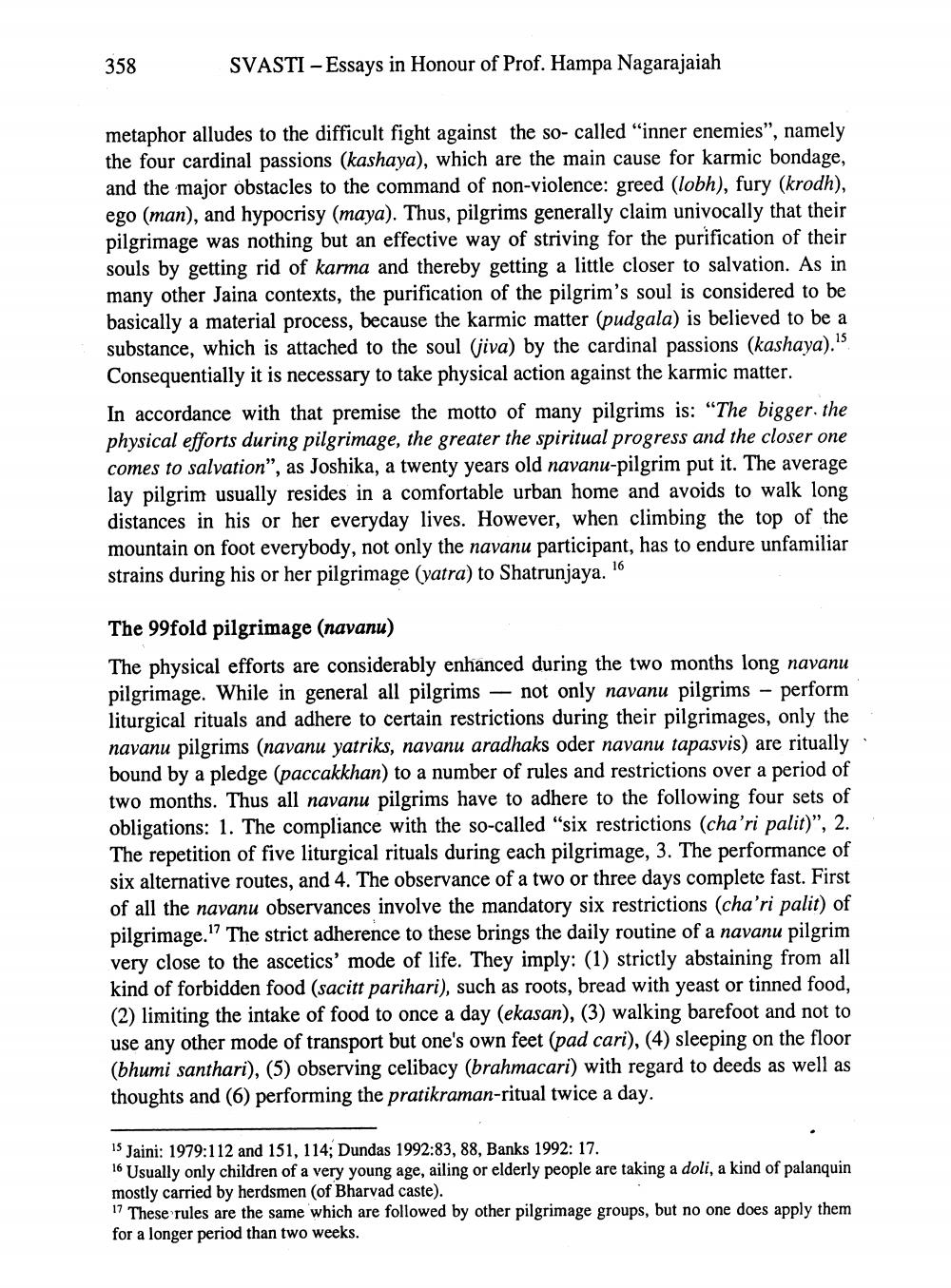________________
358
SVASTI - Essays in Honour of Prof. Hampa Nagarajaiah
metaphor alludes to the difficult fight against the so-called "inner enemies", namely the four cardinal passions (kashaya), which are the main cause for karmic bondage, and the major obstacles to the command of non-violence: greed (lobh), fury (krodh), ego (man), and hypocrisy (maya). Thus, pilgrims generally claim univocally that their pilgrimage was nothing but an effective way of striving for the purification of their souls by getting rid of karma and thereby getting a little closer to salvation. As in many other Jaina contexts, the purification of the pilgrim's soul is considered to be basically a material process, because the karmic matter (pudgala) is believed to be a substance, which is attached to the soul (jiva) by the cardinal passions (kashaya)." Consequentially it is necessary to take physical action against the karmic matter. In accordance with that premise the motto of many pilgrims is: "The bigger the physical efforts during pilgrimage, the greater the spiritual progress and the closer one comes to salvation”, as Joshika, a twenty years old navanu-pilgrim put it. The average lay pilgrim usually resides in a comfortable urban home and avoids to walk long distances in his or her everyday lives. However, when climbing the top of the mountain on foot everybody, not only the navanu participant, has to endure unfamiliar strains during his or her pilgrimage (yatra) to Shatrunjaya. 16
The 99fold pilgrimage (navanu) The physical efforts are considerably enhanced during the two months long navanu pilgrimage. While in general all pilgrims — not only navanu pilgrims - perform liturgical rituals and adhere to certain restrictions during their pilgrimages, only the navanu pilgrims (navanu yatriks, navanu aradhaks oder navanu tapasvis) are ritually bound by a pledge (paccakkhan) to a number of rules and restrictions over a period of two months. Thus all navanu pilgrims have to adhere to the following four sets of obligations: 1. The compliance with the so-called "six restrictions (cha'ri palit)", 2. The repetition of five liturgical rituals during each pilgrimage, 3. The performance of six alternative routes, and 4. The observance of a two or three days complete fast. First of all the navanu observances involve the mandatory six restrictions (cha'ri palit) of pilgrimage." The strict adherence to these brings the daily routine of a navanu pilgrim very close to the ascetics' mode of life. They imply: (1) strictly abstaining from all kind of forbidden food (sacitt parihari), such as roots, bread with yeast or tinned food, (2) limiting the intake of food to once a day (ekasan), (3) walking barefoot and not to use any other mode of transport but one's own feet (pad cari), (4) sleeping on the floor (bhumi santhari), (5) observing celibacy (brahmacari) with regard to deeds as well as thoughts and (6) performing the pratikraman-ritual twice a day.
15 Jaini: 1979:112 and 151, 114, Dundas 1992:83, 88, Banks 1992: 17. 16 Usually only children of a very young age, ailing or elderly people are taking a doli, a kind of palanquin mostly carried by herdsmen (of Bharvad caste). 17 These rules are the same which are followed by other pilgrimage groups, but no one does apply them for a longer period than two weeks.




